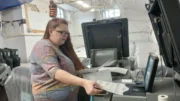SEOUL, South Korea (AP) — Calling it a “very shocking” incident, South Korea’s new liberal president on Tuesday demanded an investigation into why his office wasn’t told by defense officials about the arrival of several additional launchers for a contentious U.S. missile defense system meant to cope with North Korea’s nuclear threats.
Before taking office on May 10, Moon Jae-in vowed to review the deployment of a system that has infuriated both North Korea and China, which consider its powerful radar a security threat. Many of Moon’s supporters don’t want the system, which U.S. President Donald Trump suggested Seoul should pay for.
On Tuesday, senior presidential adviser Yoon Young-chan said in a televised news conference that Moon has discovered that four additional launchers for the Terminal High-Altitude Area Defense system have arrived in South Korea since the original two launchers were installed in April.
Yoon said that senior Defense Ministry officials didn’t report the arrival of the additional launchers when it gave Moon’s policy advisory committee a policy briefing after Moon’s inauguration.
“President Moon said it’s ‘very shocking’ after receiving a report on” the incident from his top security adviser, Yoon said.
Moon is now working with Cabinet members who were appointed by his conservative predecessor, Park Geun-hye, who was ousted from office in March over a massive corruption scandal. Moon has nominated some of his own Cabinet members, but they haven’t formally taken office. Moon was sworn in as president right after winning a May 9 by-election, and hasn’t had the usual two-month transition period.
The Defense Ministry said it would issue a statement in response to Moon’s investigation order.
A THAAD battery consists of six truck-mounted launchers that can fire up to 48 interceptor missiles, fire control and communication equipment, and a powerful X-band radar officially known as AN/TPY-2. The THAAD system was installed in the southeastern town of Seongju.
It’s unclear if Moon would go ahead with his campaign pledge to re-examine the THAAD deployment because an attempt to request the withdrawal of the system’s components could severely undermine ties with Washington, Seoul’s most important ally, analysts say. The United States stations about 28,500 troops in South Korea as deterrence against potential aggression from North Korea.
After facing conservative attacks on his security views during the election race, Moon toned down his THAAD criticism, saying the deployment would be inevitable if North Korea continued provocations.
Since Moon’s inauguration, North Korea has test-fired three ballistic missiles in an apparent demonstration of its resolve to bolster its nuclear and missile arsenals to deal with what it calls U.S. military threats. Moon has said he will employ both dialogue and pressure to resolve the North Korean nuclear standoff.







































